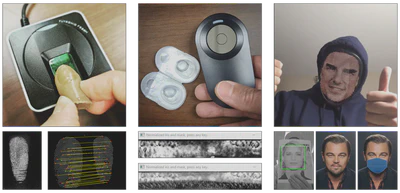Biometrics, Spring 2022

Details
Course: CSE 40537 / 60537 Biometrics
Level: Undergraduate and Graduate
Instructor: Daniel Moreira (dhenriq1@nd.edu)
Teaching Assistant: Jason You (syou@nd.edu)
Lectures: TUE and THR, 3:30 to 4:45 PM, 356A Fitzpatrick Hall
Office Hours: Daniel - MON to FRI, 5:00 to 6:00 PM, 182 Fitzpatrick Hall, Jason - WED, 1:00 to 2:00 PM, 150M Fitzpatrick Hall
Slack: https://nd-biometrics-spr22.slack.com (now deactivated)
Panopto: https://bit.ly/3A4QEKc

Course grades are now available.
Progress
- 01/11/2022 - Syllabus, Course details.
- 01/13/2022 - Basics I, Biometrics, traits, and systems.
- 01/18/2022 - Basics II, Errors, metrics, and attacks.
- 01/20/2022 - Basics II (cont.), 1st Coding Class, Metrics.
- 01/25/2022 - Fingerprint Recog. I, History and features.
- 01/27/2022 - Fingerprint Recog. II, Acquisition and enhancement.
- 02/01/2022 - Fingerprint Recog. III, Minutiae detection.
- 02/03/2022 - Fingerprint Data Collection, password with instructor.
- 02/08/2022 - Iris Recog. I, Why irises and irises vs. other traits.
- 02/10/2022 - Iris Recog. II, Acquisition and enhancement.
- 02/15/2022 - Iris Recog. III, Description and matching.
- 02/17/2022 - 2nd Coding Class, Fingerprint recognition.
- 02/22/2022 - Iris Data Collection, password with instructor.
- 02/24/2022 - 3rd Coding Class, Iris recognition.
- 03/01/2022 - 1st Invited Talk, Dr. Andrey Kuehlkamp.
- 03/03/2022 - Midterm exam, grades.
- 03/08/2022 - Spring Break.
- 03/10/2022 - Spring Break.
- 03/15/2022 - Face Recog. I, Why faces and faces vs. other traits.
- 03/17/2022 - Face Recog. II, Acquisition and enhancement.
- 03/22/2022 - Face Recog. III, Description and matching.
- 03/24/2022 - Face Recog. IV, Deep learning face recognition.
- 03/29/2022 - 4th Coding Class, Face recognition.
- 03/31/2022 - Feature Indexing, Index building and feature querying.
- 04/05/2022 - Other Traits, Alternative traits and Soft Biometrics.
- 04/07/2022 - Multibiometrics, Data fusion.
- 04/12/2022 - 2nd Invited Talk, Mr. Aidan Boyd.
- 04/14/2022 - Fingerprint presentation attack day.
- 04/19/2022 - Iris and face presentation attack day.
- 04/21/2022 - Grad students’ signature recog. and gender from iris.
- 05/05/2022 - Final exam, grades.
Assignments
- 01/20/2022 - 1st assignment, good answers, grades.
- 02/22/2022 - 2nd assignment, good answers, grades.
- 03/15/2022 - 3rd assignment, good answers, grades.
- 04/04/2022 - 4th assignment, good answers, grades.
Important Dates
01/28/2022 - 1st assignment due date.02/03/2022 - Fingerprint data collection.02/22/2022 - Iris data collection.03/01/2022 - Dr. Andrey Kuehlkamp’s talk.03/03/2022 - Midterm exam.03/04/2022 - 2nd assignment due date.03/25/2022 - 3rd assignment due date.04/12/2022 - Mr. Aidan Boyd’s talk.04/14/2022 - Fingerprint presentation attack day.04/18/2022 - 4th assignment due date.04/19/2022 - Iris and face presentation attack day.04/21/2022 - Grad students’ final report presentation.05/05/2022 - Final exam, 10:30 to 12:30 PM, 356A Fitzpatrick Hall.
Invited Talks
 |
Dr. Andrey Kuehlkamp Postdoctoral Research Associate at the Center for Research Computing, University of Notre Dame |
 |
Mr. Aidan Boyd Ph.D. Candidate at the Department of Computer Science and Engineering, University of Notre Dame |
| Using human perception to train better CNNs Traditional deep learning is a data-driven process. Images are shown to a CNN and it is expected to learn rules that enable it to perform a task efficiently on new unseen images after training. The problem with this approach is that the model can only learn from the supplied training data. Potentially, this training data is not representative of the entire domain. Although the model classifies training images near perfectly, this learned rule may actually just be coincidental to this data, rather than applying to all images in that task. Additionally, the decision making of these models can be ambiguous and not explainable, meaning it can be difficult to trust the classifications. Humans, however, possess great ability to generalize what they have seen in the past and apply it to the current task. Humans don’t focus on incidental features in data, instead we tend to look at more obvious occurrences that can be easily explained. This talk will cover two of my recent works where we investigated whether the incorporation of human perception into the training of deep learning models results in better performance on unseen data. Each of these works approach this in different ways, both showing promising results. In the second work, we also investigate whether the models we have trained in this way are more “human-like” in their decision making. These approaches are applied to the domains of iris presentation attack detection and synthetically generated face detection (see www.thispersondoesnotexist.com for examples of synthetically generated faces). |
Grading
| Concept | Point interval | Concept | Point interval | Concept | Point interval | Concept | Point interval |
|---|---|---|---|---|---|---|---|
| A | [94, 100) | B+ | [88, 89] | C+ | [78, 79] | D | [60, 69] |
| A- | [90, 93] | B | [84, 87] | C | [74, 77] | F | [0, 59] |
| B- | [80, 83] | C- | [70, 73] |
Distribution
- Total: 100 points
- Assignments: 10 points (x4)
- Presentation attack detection report: 20 points
- Midterm exam: 20 points
- Final exam: 20 points
- Late assignments: -1 point per day
Final project grades.
Links
- Classroom recording notification.
- Yale face dataset, used in the 4th assignment.
Biometrics on the News
Posted by the students and instructor on Slack:
-
https://fortune.com/2021/10/22/crypto-worldcoin-cryptocurrency-eye-scan-biometrics-orb/
-
https://www.yahoo.com/news/irs-wants-scan-face-171738919.html?.tsrc=fp_deeplink
-
https://www.nytimes.com/2022/02/14/technology/texas-facebook-facial-recognition-lawsuit.html
-
https://abcnews.go.com/GMA/Living/video/hyper-realistic-face-masks-optical-illusions-needed-71835222
-
https://www.yahoo.com/news/ukraine-using-facial-recognition-tech-153640828.html
-
https://www.nytimes.com/2022/04/07/technology/facial-recognition-ukraine-clearview.html
-
https://www.washingtonpost.com/technology/2022/04/15/ukraine-facial-recognition-warfare/
-
https://www.theverge.com/22672123/ai-voice-clone-synthesis-deepfake-applications-vergecast